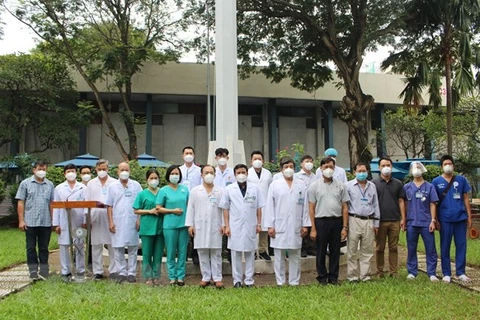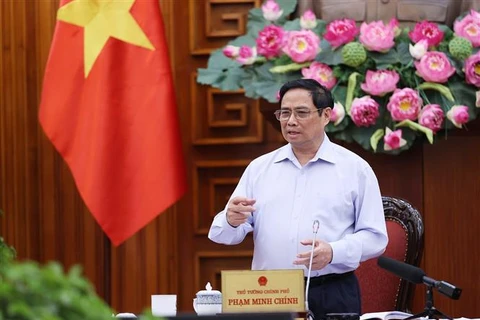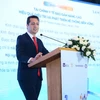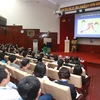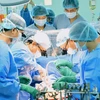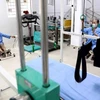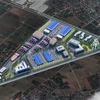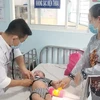 Medical workers from the central-southern province of Binh Dinh express their determination as they head to HCM City to support COVID-19 prevention and control.(Photo: VNA)
Medical workers from the central-southern province of Binh Dinh express their determination as they head to HCM City to support COVID-19 prevention and control.(Photo: VNA) Nearly 9,400 medical workers all over the country resigned their jobs recently, according to statistics of the Ministry of Health (MoH).
In only December last year, 4,864 medical workers in State medical facilities across the country quit their jobs, including 1,504 doctors.
At central-level hospitals, 420 medical workers left their jobs, 168 of them doctors.
During the COVID-19 pandemic, medical workers had to work at a high intensity, often day and night, and many even contracted the virus. But their salaries were low, not enough for their daily expenses.
Dong Tam Ward Medical Station in Hai Ba Trung district of Hanoi has 10 medical workers, including one doctor, but had to take care of 2,000 COVID-19 patients.
During the biggest outbreak in Hanoi, all 10 members of staff tested positive but they could not rest and still worked normally.
Despite fever and coughing, they still answered phone calls to give guidance to other patients, transfer serious patients to upper-level hospitals, and did other administrative work.
Doctor Nguyen Minh Hue, head of the station, said with such hard work, monthly salary of a station member was 3-5 million VND (128-213 USD). Hue herself, with nearly 30 years of doing the job, receives 10 million VND (427 USD) per month.
The Dong Tam Medical Station so far luckily to maintain its workforce, no one left their job, but Hue said, their lives were very difficult.
She said: “We do it because we love the job, it is our passion, here we love and share the work together like a family. Without the love, it will be difficult to retain our medical staff.
“If they leave, it will be very difficult for the grassroots health care sector, which has suffered from staff shortages like now.”
What worries Hue is that now many doctors and medical staff quit their jobs to work in private hospitals, which will pay them three times higher.
She added: “During the pandemic, we shared difficulties with the nation. I have done the work for a long time, I love my job and I still stay.
“But as for young medical staff, with a too low salary, finding other work with higher salary is inevitable. Hanoi authorities said that in the future, it will pay more attention to medical staff and we hope this will happen."
Nguyen Cong Huu, Director of E Hospital, said that recently, many young doctors and nurses asked to leave.
He said: “A doctor often needs nine years for studying professional knowledge. But when starting working at hospital, their initial salary is very low, and during the COVID-19 pandemic, their salary is not enough for themselves, not to mention their families. They often apply for work at private hospitals with higher income.”
A report by the Hanoi People's Committee said that from last year to April 30 this year, as many as 857 people working in the health sector quit their jobs. The reason is said that medical staff must perform many tasks, have to work overtime, but their income is very low compared with non-public medical facilities.
In HCM City, in the first three months this year, nearly 400 medical workers left their jobs. The southern province of Dong Nai the first six months this year saw 230 medical workers quit. The same situation happened in the Central Highlands province of Gia Lai with 23 people resigning.
Pham Van Dung, Director of Thong Nhat Hospital in Dong Nai province, said that the work pressure was so great and income not equal to their efforts.
Solutions
Deputy Minister of Health Do Xuan Tuyen told the press that in the past, the MoH offered many solutions, of which for grassroots health care, it was drafting a circular to increase the number of medical workers working at communal and district health stations.
The number will be based on population density in the localities to ensure sufficient medical staff to serve professional tasks and pandemic prevention and control.
The MoH will improve capacity of grassroots health care by actively implementing a project of bringing young doctors to work in disadvantaged areas, which is often called Project 585.
The project aims at bringing qualified doctors to take care of people in remote areas, border areas, islands and areas with extremely difficult socio-economic conditions. Priority is given to 62 poor districts. It aims to provide quality medical services at the grassroots level, contributing to ensuring fairness and efficiency in people's health care and protection.
At a recent Government meeting with ministries on solutions to ensure drugs, medical supplies and medical personnel, Prime Minister Pham Minh Chinh noted the MoH coordinate with other ministries to research and propose amendments to the Decree 56/2011/NĐ-CP stipulating preferential allowances for employees working at public health facilities. The decree will continue to implement support policies for medical staff and workers affected by the COVID-19 pandemic.
Tuyen said that the MoH proposed the Government adjust the Decree 56/2011/ND-CP issued on July 4, 2011 stipulating preferential allowances for public employees, in which allowances for health workers in state health facilities are expected to raise.
Associate professor Nguyen Huy Nga, former director of the Department of Preventive Medicine under the MoH, said that to develop public health, it was necessary to have a decent salary.
In the pandemic, remuneration for pandemic prevention and control must be paid quickly.
A study conducted by the Vietnam Young Physicians’ Association of 2,700 health workers across the country revealed that more than one third of them said that their salaries, bonuses and allowances had been reduced.
As many as 62% of health workers surveyed have not received any allowance. More than 80% cannot pay or can only pay a part of living expenses for themselves and their families./.
VNA
